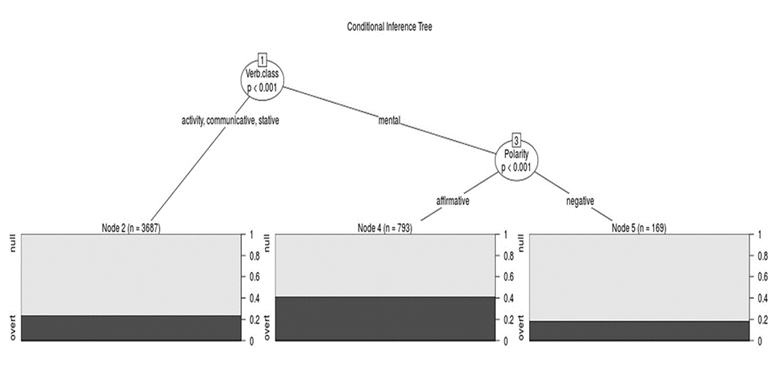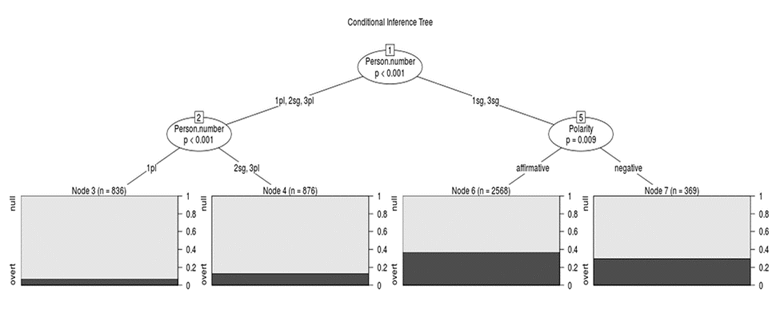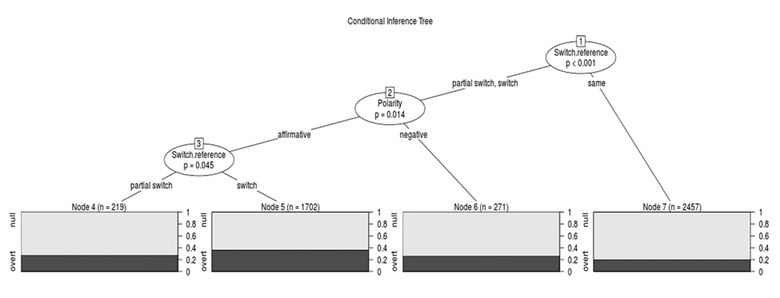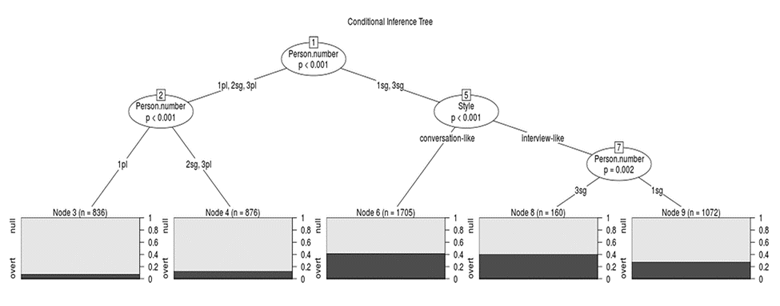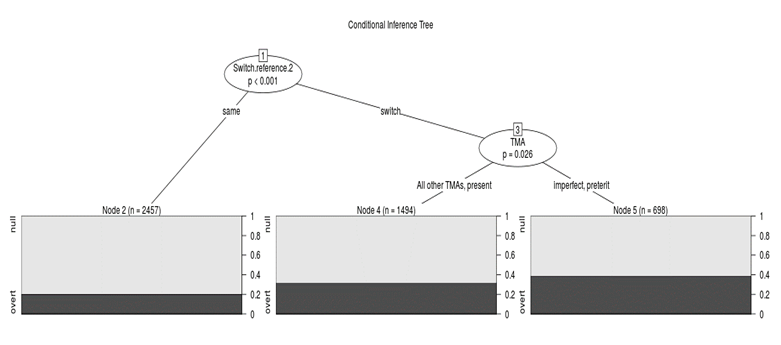1. Introduction
While there has been a tremendous amount of research on both the occurrence rates and conditioning factors of variable subject pronoun expression (SPE) in Spanish (e.g., «yo tengo» vs. «tengo» «I have» vs. «[I] have») (e.g., Silva-Corvalán, 1982; Cameron, 1994; Flores-Ferrán, 2004; Otheguy, Zentella, & Livert, 2007; Travis, 2007; Torres Cacoullos & Travis, 2010; Otheguy & Zentella, 2012; Carvalho, Orozco, & Shin, 2015), much less is known about the nonorthogonal role that such conditioning factors play. There is a growing interest in interaction effects on SPE as seen by the work on the joint effect of factors such as lexical frequency, tense-mood-aspect (TMA), and switch reference (e.g.,, Cameron, 1994; Erker & Guy, 2012; Shin, 2014). However, various factors remain underexplored such as polarity and speech style. The current paper aims to fill this gap and to add to the growing body of scholarship on interaction effects by examining the potential nonorthogonal (non-independent) role of linguistic factors on variation between null and overt subject pronouns (SPs) in Spanish. The following research questions guide the present study:
In what ways do linguistic variables interact with one another to constrain variable SPE?
How do such interactions compare with those observed in previous research?
What role, if any, do understudied variables (e.g., polarity, speech style) play in the conditioning of SPE?
What do these patterns tell us about the nuances of the variable grammar concerning SPE in Spanish?
To answer these questions, a quantitative analysis of conversational data was carried out, collected via sociolinguistic interviews with Spanish-speakers in the state of Georgia (Limerick, 2018). Factors such as polarity, speech style, TMA, switch reference, and person/number were examined, specifically regarding the ways in which these factors jointly condition variable SPE.
This paper will start with an overview of research that has treated interaction effects on SPE in the sociolinguistics literature, particularly factors addressed for the current study (Section 2). Next, the methodology employed for the current analysis will be outlined, including the interview data and description of quantitative analyses carried out to test for interaction effects (Section 3). Then, the results are presented, which demonstrate the nuances observed for linguistic constraints on SPE (Section 4). Finally, a discussion of the implications of the results, a general summary, and a conclusion will be presented, and some questions for future research will be proposed (Section 5).
2. Previous Research on Interaction Effects
In order to provide some background for the current study of interaction effects, some of the studies that have examined such interactions will be briefly discussed (e.g.,, Cameron, 1994; Erker & Guy, 2012; Shin, 2014), outlining the main findings as well as highlighting the gaps in the literature.1 Perhaps one of the most well-known SP studies that analyzes interactions is that of Cameron (1994), which looks at the combined effect of switch reference and TMA. In his study, Cameron found that the TMA effect was heightened with cases of switch reference when compared to cases of same reference. This effect was replicated by Shin (2014), in which she argued that the main motivation for this effect is due to the ambiguity of subject referent with both (a) morphological ambiguous verbs (e.g., imperfect) and (b) switch in subject referent. Shin found that imperfects favored overt SPs, particularly in contexts of switch reference and with competing referents, both contexts in which referential tracking is more difficult. Other interactions effect pertaining to SPE analyzed include the factors of lexical frequency, person/number, etc. For instance, Erker & Guy (2012) explored the influence of the verb’s lexical frequency on subject expression, finding that, while a main effect was not operative, additional factors played a role of amplifying a frequency effect. That is, while there was no direct and main effect of frequency on pronoun variation, frequency interacted with factors such as TMA and person/number to condition subject expression.
2.1. Polarity
Polarity considers affirmative vs. non-affirmative clauses and their conditioning on SP variation. While still relatively understudied, this variable has occasionally been analyzed in previous research, with some researchers finding a significant effect (Lastra & Martín Butragueño, 2015; Geeslin & Gudmestad, 2016) and others reporting a lack of effect (Travis & Torres Cacoullos, 2012; Torres Cacoullos & Travis, 2015). For example, Lastra and Martín Butragueño (2015) found that non-affirmatives (negatives and interrogatives) disfavored overt SPs and that affirmatives showed a neutral effect. These authors give a possible explanation for this pattern in terms of the frequent clustering together of negative clauses in their data, which tend to be coreferential. They hypothesize that «if negated clauses cluster together, it is possible that co-reference across these negated clauses contributes to their disfavoring effect on overt SPPs» (Lastra & Martín Butragueño, 2015, p. 46). In other words, there could be an interaction between the switch reference and polarity variable such that negative clauses disfavor overt SPs more frequently in coreferential contexts than in switch reference contexts.
Likewise, Geeslin and Gudmestad (2016) found that negation disfavored overt SPs, while affirmative clauses favored them. This finding confirmed their prediction based on previous research that the presence of pre-verbal elements make null SPs more likely. Interestingly, this variable was only significant for first-person singular forms and not for second-person singular forms in Geeslin and Gudmestad’s analysis, which calls for further research on the interaction of negation and person.
Furthermore, Travis and Torres Cacoullos (2012), while not finding a significant effect for polarity overall, did find effects upon considering particular verb classes/lexemes. Their study revealed interesting patterns in the distinction between cognitive and non-cognitive verbs and their influence on polarity, namely that negation favored overt SPs, but only for non-cognitive verbs. Moreover, although a significant effect for cognitive verbs was not found overall, the researchers did find an effect when considering only the particular verbal lexeme creo, specifically that negation highly disfavored overt SPs (e.g., ∅ no creo) (Travis & Torres Cacoullos, 2012, p. 741, note 23).
To summarize, the findings across studies for polarity have been somewhat conflicting, with some finding it to be significant and others lacking an effect. Additionally, the general finding that negation disfavors overt SPs (Lastra & Martín Butragueño, 2015; Geeslin & Gudmestad, 2016) may only apply to cognitive verbs, based on evidence from Travis and Torres Cacoullos’s (2012) analysis. The present study intends to study this variable further, including its potential interaction with other independent variables such as switch reference, person/number, and verb class. In the next part (2.2.) , the factor of speech style will now be discussed, whose potential role in subject variation also will be explored in the current study.
2.2. Speech Style
The linguistic style of the speaker has also been found to constrain subject expression (e.g., Ávila-Jiménez, 1996; Lastra & Martín Butragueño, 2015). Ávila-Jiménez (1996), for instance, reported that more casual speaking favored overt SPs in Puerto Rican Spanish. Similarly, Lastra and Martín Butragueño (2015) found that Mexico City speakers tended to use more overt SPs for more conversational styles, particularly when they had longer speech turns in the latter part of their interviews, which also contained a higher use of argumentation, as opposed to shorter speech turns at the beginning of the interview (less conversational), for which they used fewer overt SPs. Although these authors do not explain possible reasons for such patterns, It is suspected that it is related to more careful speech being used near the beginning of the interview and less careful (more casual) speech as the interview progresses. Careful speech styles, being subject to more self-monitoring and perhaps focus on using more prescriptive grammar norms, would be more likely to comprise null pronouns. More casual speech, on the other hand, without such restrictions, would be more likely to employ overt SPs.
Speech style is relatively understudied, however, which motivates further analysis as part of this dissertation. Particularly, the call from Lastra and Martín Butragueño (2015, p. 49) for future research to investigate the interaction between style with person/number is of interest in the present study. Their suggestion to examine this interaction is based on opposite patterns for style being found in previous research that included only first-person singular SPs (e.g., Blanco Canales, 1999; Travis, 2007) while their analysis included all persons/numbers.
3. Methodology
This study employs data from sociolinguistic interviews conducted in Roswell, Georgia (Atlanta suburb) in the summer of 2015 (Limerick, 2018). The sample for the current analysis consists of 20 first-generation Mexican immigrants living in Georgia at the time of interview, and whose average length of residency in the U.S. was 12 years. Additionally, their ages ranged from 25 to 60, and they consisted of 12 females and 8 males. In terms of education levels, they ranged from primary school to university. The speakers had a variety of occupations, nearly half of them being small business owners.2 In order to explore the relationship among the independent variables in the data and to spot potential interactions between them, cross-tabulations and conditional inference tree analysis were employed. These particular types of analysis will reveal which variables interact with each other to constrain subject expression. In other words, they helps us to determine when a single independent variable (e.g., person/number) is constrained by another independent variable (e.g., switch reference) in its conditioning of SP variation, rather than having an effect on the data set as a whole.3 Thus, for example, person/number and switch reference could interact in such a way that third-person singular tokens favor overt SPs, but only (or to a greater degree) when there is a switch in subject referent (not for cases of same reference). Cross-tabulations and conditional inference trees help us to reveal such complex relationships in the dataset.
Below (Section 4) discusses how the variables interact with each other to influence variable subject expression in order to get a more in-depth and nuanced picture of how a speaker’s choice in pronoun use is determined. As stated above, the interactions by means of conditional inference trees were examined (Tagliamonte & Baayen, 2012) as well as cross-tabulations. Conditional inference trees are useful statistical tools, using branching structures that display statistically significant interactions between the independent variables in a given dataset. They allow researchers to efficiently locate and visualize interactions in their data (Tagliamonte, 2012; Tagliamonte & Baayen, 2012; Schwenter, 2017). The conditional inference trees were created using the recently developed statistical program Language Variation Suite (Scrivner & Díaz-Campos, 2016). The splits in the branching structures shown in the trees (see Figures 1 - 5 below) indicate a) instances in which particular contexts for a given variable exhibit significantly different pronoun frequencies and b) how this variable interacts with other variables. For example, it will be shown below in Figure 5.1 that verb class splits into mental verbs on one side, and all other verb types on the other side, indicating that mental verbs behave differently from other verbs. Additionally, the mental verbs branch splits off further to interact with polarity, which then splits into affirmative and negative. What it will be demonstrated is that the main effect of certain independent variables are not operative across the data set as a whole, but rather interact with other independent variables. The particular interactions tested for are based on previous SP literature that has drawn attention to the need for research on such interactions, namely those of polarity with verb class (Travis & Torres Cacoullos, 2012), polarity with person/number (Geeslin & Gudmestad, 2016), polarity with switch reference (Lastra & Martín Butragueño, 2015), and style with person/number (Lastra & Martín Butragueño, 2015). Additionally, the joint effect of TMA and switch reference will be explored in order to further address the notion of ambiguity as a potential explanation for heightened overt pronoun usage (Cameron, 1994; Shin, 2014). The next part will begin with an explanation of the interaction between polarity and verb class.
4. Results
4.1. Polarity and Verb Class
Regarding polarity and verb class, the conditional inference tree shown in Figure 1 below illustrates the following information: verb class is split between mental verbs on one hand (which favor overt SPs) and activity, communicative, and stative verbs on the other hand. This split indicates that mental verbs behave significantly different from the other verb classes. Most revealing, however, is the interaction we see between mental verbs and polarity on the right side of the tree, which shows that mental verbs favor overt SPs when they are affirmative but not when they are negative. Specifically, we see an overt rate of 41 % in affirmative contexts and only 18 % with negatives, as illustrated by the black shaded regions of the middle and right-hand bars of the tree, respectively. In contrast, the other three verb classes on the left side of the tree do not interact with polarity in any way as we do not see any additional branches for affirmative and negative.
The tree also shows that the polarity effect (Limerick, 2018) applies only to mental verbs and is not operative for the other verb classes. The cross tab shown in Table 1 below shows the relationship between verb class and polarity in more detail with the specific overt pronoun frequencies for each verb Class and polarity category. The cross tab indicates that it is the mental verbs that show the greatest distinction between affirmative and negative polarity (a difference of 23 percentage points) and that the other verb classes do not show such a distinction. In other words, polarity is only operative for mental verbs. It may be the case that the particular negative polarity token ∅ no creo «(I) don’t think» is driving this pattern, as was found by Travis and Torres Cacoullos (2012, p. 741) as well as Posio (2015). Further research is required, however, to uncover potential verb lexeme effects.4
4.2. Polarity and Person/Number
A significant interaction was also found between polarity and person/number. Specifically, both first-person singular and third-person singular forms favor overt SPs when they are affirmative (38 % overt) but not when they are negative (29 % overt), as seen on the right side of the tree in Figure 2. We do not see any interaction with polarity for the other persons/numbers. The left side of the tree simply illustrates that second-person singulars and third-person plurals are significantly more likely to appear with overt SPs than are first-person plural forms. Furthermore, we again see, as was shown with the interaction with verb class in the previous section, that the polarity effect applies only to certain environments. In this case those environments are first-person and third-person singular verbs.5
The cross tab in Table 2 below shows the differences in overt frequencies for each person/number according to polarity. These rates further reveal that the polarity effect is greater for third-person singular verbs relative to first-person singulars, with a percentage difference of 12 and 7, respectively. The cross tab also confirms the lack of interaction between 1pl, 2sg, 3pl and polarity, with very small percentage differences between affirmative and negative.
Table 2 Rate of overt SPE according to polarity and person/number
| 1sg | 2sg | 3sg | 1pl | 3pl | |
| Affirmative | 37 % | 13 % | 39 % | 7 % | 13 % |
| Negative | 30 % | 14 % | 27 % | 8 % | 10 % |
The result that the polarity effect is operative for first-person singular forms but not for second-person singular forms is consistent with Geeslin and Gudmestad’s (2016) findings for native speakers in their study.6
4.3. Polarity and Switch Reference
Regarding the interaction of polarity with the switch reference variable, Figure 3 below shows that it is the noncoreferential environments (both switch and partial switch) that interact with polarity. By contrast, the coreferential environments (i.e., same reference) do not show an interaction. In particular, when there is a switch in subject referent, affirmative clauses favor overt SPs over negative clauses. Moreover, affirmative contexts further interact with switch reference, showing a favoring of switch over partial switch contexts, a distinction not seen for negative contexts. The cross tab shown in Table 3 further reveals that it is switch reference contexts, as opposed to partial switch, that drive the polarity pattern (a wide distinction of 36 % affirmative vs. 27 % negative for switch reference, as opposed to virtually no difference with 28 % affirmative vs. 29 % negative for partial switches).
Table 3 Rate of overt SPE according to polarity and switch reference
| Same | Switch | Partial switch | |
| Affirmative | 20 % | 36 % | 28 % |
| Negative | 19 % | 27 % | 29 % |
As previously mentioned, Lastra and Martín Butragueño (2015) hypothesized that the disfavoring of overt SPs with negative clauses may be due to the clustering together of such clauses in primarily coreferential (i.e., same reference) contexts (a context which also disfavors overt SPs). This explanation is not borne out in the current data, however, since negative clauses that are in same reference contexts do not show a significantly reduced overt rate compared to affirmative clauses in same reference contexts. In fact, they are virtually the same, with 19 % overt for the former and 20 % for the latter, as seen in Table 3.
4.4. Style and Person/Number
As discussed above, the interaction of speaker style and person/number deserves some attention (Lastra & Martín Butragueño, 2015). Analysis of these two variables together in the current data indeed reveals a statistically significant interaction. As seen from the conditional inference tree below (Figure 4), the environment where style intersects with person/number is particularly the use of first-person singular and third-person singular verbs. Specifically, third-person singulars behave significantly different from first-person singulars (41 % overt for the former and 28 % overt for the latter) for interview-like tokens (more formal), but not for conversation-like tokens (more casual). This means that, as the sociolinguistic interviews progressed, the difference between these two persons/numbers was neutralized; that is, third-person singular overt use decreased and first-person singular overt use increased. Thus, the observation that third-person singular outweighs first-person singular in the data is only the case for interview-like (more careful) speech. One explanation for this effect is that perhaps speakers were more concerned with and more careful about facilitating referential tracking in the beginning stages of the interviews (thus more overt SPs with third-person singular which are less contrastive morphologically than first-person singular), and not as careful in the latter stages when they were paying less attention to their speech. Furthermore, a cross tab reveals that the overall style effect (more overt SPs with conversation-like tokens) only applies to first-person singular and not to the other persons/numbers (See Table 4 below). This pattern is seen by the substantial difference in frequencies for first-person singular conversation-like (42 %) vs. interview-like (28 %) that is not seen for other persons/numbers. This could be due to the fact that more mental verbs (e.g., creer «believe/think»; pensar «think») tend to appear in the latter stages of the interview, particularly in which speakers are forming opinions on different topics. As mentioned above, mental verbs tend to favor overt SPs. The first-person singular verbs creo and pienso have the highest overt pronoun rates (69 % and 67 %, respectively), so the finding that the style effect applies only to first-person singular forms may have to do with the more frequent occurrence of creo and pienso among the conversation-like tokens opposed to the interview-like tokens.
4.5. TMA and Switch Reference
Interestingly, when the Roswell data was tested for TMA as a main effect, it was not found to be significant (Limerick, 2018), a rather unexpected finding. In contrast to most previous studies that have found a strong effect for TMA, with an increased use of overt SPs with the imperfect relative to the preterit, Roswell speakers did not show such a distinction between aspects. In terms of interactions, however, TMA did interact with another factor, namely switch reference. Nevertheless, the same unexpected result for TMA remains. Speakers do not distinguish between imperfect and preterit verbs in terms of their overt SP frequencies, regardless of whether or not there is a switch in subject referent. Concerning the interaction effect in particular, TMA emerges as significant in switch reference contexts, but not in same reference environments, as seen in Figure 5.
This general effect is consistent with previous studies that have tested this interaction (Cameron, 1994; Shin, 2014). However, the specific effect is quite different. That is, the distinction in pronoun rates being made in switch reference contexts is not between the imperfect and the preterit, but between past tense forms in general (imperfect/preterit both with high pronoun usage) and all other TMAs (lower pronoun usage) (see also Table 5 for comparison).
Table 5 Rate of overt SPE according to TMA and switch reference
| Imperfect | Preterit | Present | All other TMAs | |
| Same | 23 % | 22 % | 18 % | 20 % |
| Switch | 38 % | 40 % | 32 % | 35 % |
Thus, we are seeing an extension and generalization of the TMA effect to now include preterit contexts. At the same time, speakers are holding on to their relatively high overt SP use with imperfect (38 %). For example, we are not seeing a decrease in the use of SPs in imperfect environments. Therefore, there could still be a disambiguating strategy at play, especially since the factor of morphological ambiguity was significant, as discussed in Limerick (2018).7 In sum, while speakers in the current data are not guided by TMA as a whole (absence of a main effect), they are guided by it in combination with other environments, namely when there is a switch in subject referent. This effect is unique in that speakers are simplifying the TMA constraint in these contexts by increasing their usage of overt SPs with the preterit. As for the motivations for such a distinct effect, this pattern could be an effect of bilingualism and/or dialect contact between Mexican varieties, but the particular influence remains to be seen in future work.
5. Discussion and Conclusions
What do the interactions among the linguistic variables reveal about the Georgia data? In other words, what can the non-independent effects on SP variation show us concerning variable subject expression in the current data? In examining interactions between the independent linguistic variables, several factors demonstrated a non-independent effect on subject expression. Particularly, polarity interacted with several variables, namely verb class, person/number, and switch reference. Regarding verb class, the polarity effect (affirmatives favoring overt SPs) is only operative for mental process verbs and not for the other verb classes. It is proposed, though tentatively, that the particular verbal lexeme creo ‘(I) think’ may be the driving force behind this interaction effect, a finding consistent with the analysis of Travis and Torres Cacoullos (2012). These researchers examined subject expression with the use of creo in particular and observed a strong disfavoring of overt SPs in negative polarity environments (i.e., ∅ no creo). This general interaction in the current study between polarity and verb class also indicates that the verb class effect (mental verbs favoring overt SPs) only applies to negative polarity contexts. To explain such effects, many researchers have found that some linguistic items tend to chunk together in the speaker’s memory and form what are called formulaic sequences (e.g.,, Wray, 2002; Posio, 2015). For the current study, the particular formulaic sequences would be the affirmative yo creo and the negative ∅ no creo given the favoring of overt SPs with the former (positive polarity) and disfavoring of overt SPs with the latter (negative polarity). Such an explanation, particularly for the lexeme creo (among others, such as ∅ no sé), has in fact been proposed by other researchers (Travis & Torres Cacoullos, 2012; Posio, 2015).
With regard to person/number, the interaction shows the following patterns: the polarity effect only applies to first-person and third-person singular verbs. The finding concerning the significance of first-person singular verbs in particular is consistent with Geeslin and Gudmestad’s (2016) analysis, in which they found that polarity was operative only for first-person singular and not for second-person singular forms among native speakers. Moreover, the effect of person/number is stronger in affirmative contexts than in negative contexts. This could be due to the added length of the clause once it is negated. In negative contexts, the overt SP is less common with first-person and third-person singular verbs (e.g.,, ∅ no tengo, ∅ no tiene), and adding the overt SP would lengthen the clause (yo no tengo) more than it would in affirmative contexts (yo tengo). Thus, for reasons of efficiency and expediency of communication, speakers may avoid using as many overt SPs as they do in affirmative contexts. This makes the favoring overt SP effect for first-person and third-person singular verbs relative to plural verb forms weaker in negative contexts (see, e.g.,, Shin, 2010 and references therein for discussions of communicative efficiency).
For polarity’s interaction with switch reference, the polarity effect is only operative in switch reference (noncoreferential) environments (including both switch and partial switches). This finding contradicts the hypothesis proposed by Lastra and Martín Butragueño (2015) that negation favors null SPs due to its frequent co-occurrence with coreferential (i.e.,, same reference) contexts in their Mexico City data. That is, since the polarity effect in the current data does not apply to coreferential contexts, there is no relation between coreference and negative polarity such that they jointly constrain SP variation. If this were the case, we would have expected to see significant differences in overt SP rates between negative/coreferential contexts and affirmative/coreferential contexts, which we did not observe. This finding may simply be related to the distribution of the current data. Specifically, there may be fewer negative polarity tokens overall in coreferential contexts. Further contextual analysis of these environments is warranted to explore the motivations of such patterns in greater detail.
Additionally, a significant interaction was found between the variables of speech style and person/number such that the effect of style (overt SPs favored with conversation-like [more casual] speech) only applied to first-person singular environments. This finding reveals that the speech style effect is not operative for other persons/numbers, an observation not yet attested in the literature since previous studies that have analyzed style have either not taken into account other persons/numbers aside from first-person singular (e.g.,, Blanco Canales, 1999; Travis, 2007) or have not tested their possible interactions with style (e.g.,, Lastra & Martín Butragueño, 2015). It was suggested in the previous section that this particular finding could be due to the presence of more first-person singular mental process verbs (creo and pienso, in particular, which favor overt SPs) that coincided with more casual/conversation-like speech. Finally, an interaction effect was observed between TMA and switch reference, but with rather divergent patterns from previous studies reporting such an effect (Cameron, 1994; Shin, 2014). Further research is needed to address the specific motivation for the pattern found in the current data. In sum, we see that the variables of polarity, verb class, person/number, switch reference, style, and TMA do not exhibit independent effects on SP variation across the dataset, but rather intersect with each other to constrain subject expression. In other words, the effect of one variable (e.g.,, polarity) depends on the effect of another (e.g.,, verb class).
These findings reveal a more nuanced picture of variable SPE in Spanish in that they reflect a more complex variable pronoun grammar that was previously obscured by simply examining the main effects of each of the linguistic variables. Rather than exhibiting independent effects on pronoun variation, they jointly constrain SP usage by depending on each other. This finding sheds light on types of interactions not explored in previous subject expression research while at the same time confirming and corroborating findings from other researchers. Thus, the significant interactions observed in the present study reveal a more nuanced view and further our understanding of how the conditioning factors of SP variation work together while also lending support to previous subject expression scholarship. In addition, this analysis has raised interesting questions that would be a fruitful point of departure for future research. For example, does the interaction pattern found for TMA and switch reference reflect a possible change in the pronoun grammar that differentiates Spanish in Georgia from other varieties? What other linguistic factors not yet explored interact with one another to constrain variable SPE? How might social factors such as age, sex, or education intersect to condition pronoun variation? Questions such as these that would be beneficial to address in future work on the interactions of factors that constrain SPE in Spanish.













